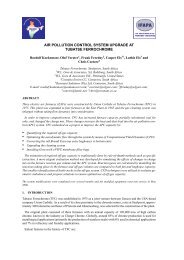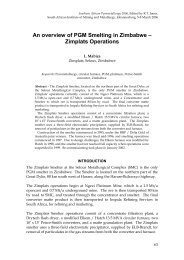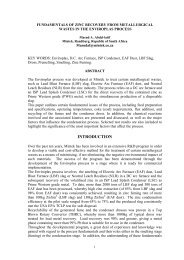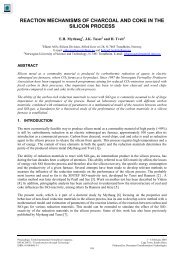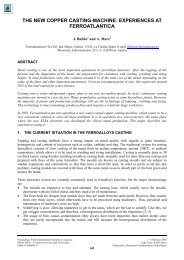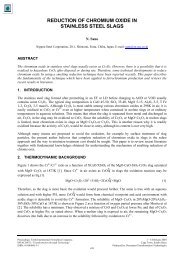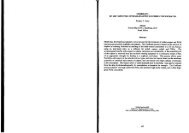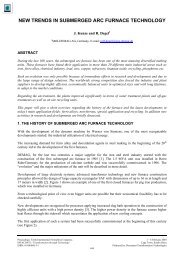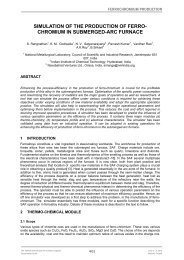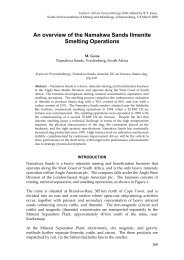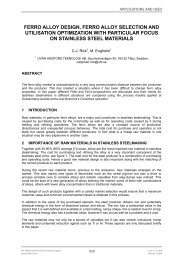You also want an ePaper? Increase the reach of your titles
YUMPU automatically turns print PDFs into web optimized ePapers that Google loves.
Ferromanganese Smelting4.2 Testwork at a GlanceTable 3:Summary of FeMn and SiMn submerged arc smelting campaignsParameter Unit DetailsManganese ferroalloy type HC FeMn SiMnPower supply type AC DC AC DCNumber of graphite electrodes three two three twoTest dates [week № in 2007] 18 19 39 45Total duration hours 72.7 53.7 38.5 134.3 138.2Downtime/”power off” time hours 4.2 2.1 1.9 22.6 20.9Roof refractory typeHigh-alumina castableBatch/heat/tapping numbers 4 - 22 25-40 41-54 0 - 11 12-28 1 - 26 27-48Warm-up tap number 4 25 0 1Burden melt-down numbers 23 - 29 - 49Furnace clean-out numbers 3, 24 - 30 - -Furnace dig-out number - 55 - - - 49High - [Mn/Fe ratio] Mn ore : massLow - [Mn/Fe ratio] Mn ore ratio ratio50:50 50:50 50:50 70:30 70:30 50:50Coke : Anthracite ratio, mass ratio 30:70 29:71 30:70 1:2Total manganese ore smelted ton 3.55 2.65 2.02 2.75 2.81Total reductant, kg per 100 kg Mn ore 26.9 23.8 26.9 45Quartzite quantity ton 0.11 0.08 0.06 1.1 1.1Limestone flux quantity kg - - - 275 282Total energy input MWh 8.94 11.69 13.63 16.56Total alloy produced # ton 1.30 1.85 1.16 1.22Total slag ton 1.07 1.52 1.95 1.94# Silico-manganese alloy masses corrected for dilution with iron from the tapping lance4.2.1 Summary of the HCFeMn campaign using a three-phase AC power supplyA typical recipe was chosen for the smelting of HCFeMn according to the discard-slag practice asperformed by South African industrial manganese ferroalloy producers, using typical South Africanmanganese ores, but no sinter. Initially a small amount of limestone flux was employed in the smeltingrecipe, but was changed to 5 kg of quartzite per 200 kg ore + reductant [from Tap 4] to obtain a slagbasicity ratio [(CaO + MgO)/SiO 2 ] close to the target value of 1.3 ± 0.1.The hydraulic electrode hoists of the pilot-plant furnace were manually adjusted to maintain electrodecurrents in the range of approximately 2 kA, with a transformer tap selection such that the averagetotal instantaneous power input to the furnace after the warm-up tap [i.e. from Tap 5 onwards] wasabout 120 kW. A statistical summary of the electrical operating data is given in Table 5.Tapping operations were attempted after an average of 394 kWh of energy input [“power on” tap-totaptime of 3.3 hours], or effectively approximately 192 kWh of energy when lost energy is subtractedbased on average heat losses (based on conduction through refractory lining only) of about 55 kWand a total average tap-to-tap time of 3.5 hours. The quantity of alloy tapped was on average about64 kg per tapping operation. The measured heat losses were calculated from sidewall film coolingwater flowrate and its temperature increase, whereas an estimated “unmeasured” value of 25 kW wasadded (from previous experience on this furnace) to obtain a value for the total average heat lossesper tap.Measurements were done to determine the distance between electrode tips and the furnace hearth. Asummary of these distances is given in Table 4.The Twelfth International Ferroalloys CongressSustainable Future500June 6 – 9, 2010Helsinki, Finland



